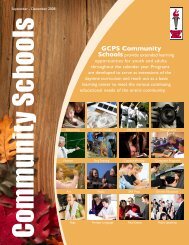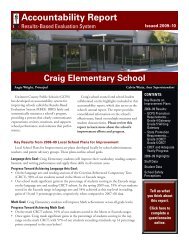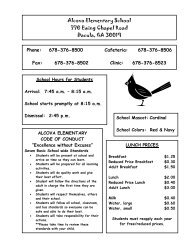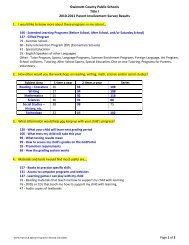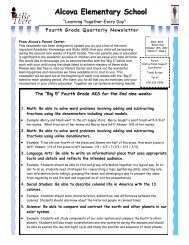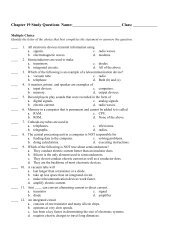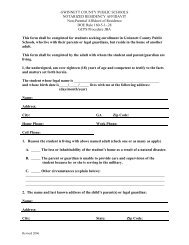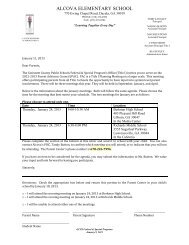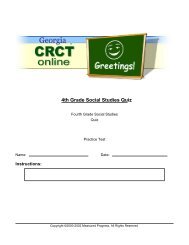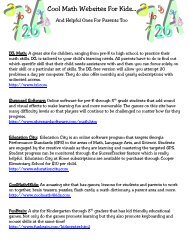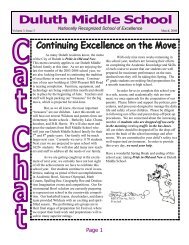21st Century Learners - Gwinnett County Public Schools
21st Century Learners - Gwinnett County Public Schools
21st Century Learners - Gwinnett County Public Schools
You also want an ePaper? Increase the reach of your titles
YUMPU automatically turns print PDFs into web optimized ePapers that Google loves.
<strong>Gwinnett</strong> <strong>County</strong> <strong>Public</strong> <strong>Schools</strong> Fall 2011<br />
<strong>21st</strong> <strong>Century</strong><br />
<strong>Learners</strong><br />
Need <strong>21st</strong> <strong>Century</strong> Skills…<br />
How GCPS <strong>Schools</strong> are Preparing<br />
Students for College, Career, and Life<br />
i
Message from the CEO/Superintendent<br />
<strong>Gwinnett</strong> <strong>County</strong> <strong>Public</strong> <strong>Schools</strong> Fall 2011<br />
Table of Contents<br />
Message from the CEO/Superintendent 1<br />
Building <strong>21st</strong> <strong>Century</strong> Skills 4<br />
Step-by-Step with Singapore Math 6<br />
About eCLASS 7<br />
Collaboration in the Classroom 8<br />
The ‘Art’ of Teaching 10<br />
Writing to Understand 12<br />
Online Learning in <strong>Gwinnett</strong> 14<br />
Communiqué Essentials 16<br />
Back to School by the Numbers 18<br />
Our Vision, Mission, and Goals<br />
GCPS’ Vision: What we aspire to be…<br />
<strong>Gwinnett</strong> <strong>County</strong> <strong>Public</strong> <strong>Schools</strong> will become a system of world-class schools<br />
where students acquire the knowledge and skills to be successful as they<br />
continue their education at the postsecondary level and/or enter the workforce.<br />
GCPS’ Mission: Why we exist, our core business…<br />
The mission of <strong>Gwinnett</strong> <strong>County</strong> <strong>Public</strong> <strong>Schools</strong> is to pursue excellence in<br />
academic knowledge, skills, and behavior for each student, resulting in<br />
measured improvement against local, national, and world-class standards.<br />
GCPS’ Strategic Goals: The plan for achieving our mission…<br />
Strategic Goals for the school system clearly connect to the vision and mission—<br />
the “world-class” status we intend to achieve.<br />
Stay Connected to GCPS<br />
• Watch GCPS TV on your local cable station or stream shows online at<br />
www.gwinnett.k12.ga.us/gcpstv/<br />
• Find <strong>Gwinnett</strong> <strong>County</strong> <strong>Public</strong> <strong>Schools</strong> on Facebook.<br />
• Follow us on Twitter at <strong>Gwinnett</strong><strong>Schools</strong>.<br />
• Check out the GCPS website at www.gwinnett.k12.ga.us where you can<br />
– sign up for RSS feeds, and<br />
– subscribe to electronic publications, including<br />
GCPS eNews and the new BeThere@GCPS e-newsletter for involved parents.<br />
There’s more!<br />
When you see “colorful” text or<br />
these icons in an article, click<br />
to hear more, see more, and<br />
learn more.<br />
Click to see<br />
a video.<br />
Click for a<br />
slideshow.<br />
Click to learn<br />
more online.<br />
Tell us what you think!<br />
Click here to take a<br />
brief online survey about<br />
Communiqué.<br />
November 8, 2011:<br />
An Important Day for <strong>Gwinnett</strong><br />
In 1996, the Georgia General Assembly passed legislation that was one of the most<br />
beneficial bills for public education ever to come out of the Gold Dome. Lawmakers<br />
approved calling for an amendment to the state’s Constitution that would allow school<br />
districts to seek approval to fund capital projects with sales taxes. The amendment<br />
passed statewide in November of 1996. And, in March of 1997, <strong>Gwinnett</strong> <strong>County</strong><br />
<strong>Public</strong> <strong>Schools</strong> (GCPS) took the special purpose local option sales tax, or SPLOST, to<br />
its citizens. It was approved by more than 71 percent!<br />
Since 1997, the <strong>Gwinnett</strong> education SPLOST has provided our students with<br />
thousands of classrooms and major technology improvements. <strong>Gwinnett</strong> voters<br />
extended the one-penny SPLOST in 2001 and 2006 by wide margins. Thanks to their<br />
approval, we were able to manage the challenges of our dramatic growth in student<br />
enrollment, rather than being managed by it. It is hard to imagine how we would have<br />
housed the students continually coming to our door without the new schools funded<br />
by the penny SPLOST.<br />
Now it is 2011 and the SPLOST is about to expire. Recently, the <strong>Gwinnett</strong> <strong>County</strong><br />
Board of Education approved asking voters to keep the one-cent SPLOST for another<br />
five years. There are a number of important reasons why the Board did so.<br />
GCPS continues to grow by almost 2,000 students a year, and we still have areas<br />
where more schools and classrooms are sorely needed.<br />
Additionally, as a result of nearly a decade of budget cuts, we have postponed<br />
preventive maintenance on our buildings. These projects— including painting, carpeting,<br />
and roofing projects— are essential to the upkeep of our facilities. We also want to aircondition<br />
all of our gyms, activity buildings, and kitchens— something many people<br />
have wanted us to do for a long time.<br />
In addition to facility improvements, technology advancements are a substantial part<br />
of this SPLOST program. The focus is on increasing access to technology, expanding<br />
our resources for teaching and learning, and supporting day-to-day processes in areas<br />
such as transportation, business and finance, and human resources. SPLOST IV would<br />
enable the school district to provide students, teachers, and parents with technology<br />
resources to improve student learning and to enhance communication at all levels.<br />
I encourage you to learn more about the school district’s needs, our plans for<br />
addressing them, how the SPLOST will benefit all of our clusters and schools, and<br />
our record of accountability for delivering what was promised in SPLOSTs I, II, and<br />
III. Revenue from the one-cent sales tax has provided tremendous benefits to our<br />
community and its schools over the last 15 years.<br />
<strong>Gwinnett</strong> <strong>County</strong> is known for its strong, successful school system. November 8<br />
will be an important day for our school district as voters head to the polls and make a<br />
decision that will have an impact on the future of GCPS.<br />
J. Alvin Wilbanks,<br />
CEO/Superintendent<br />
“I encourage you to<br />
learn more about the<br />
school district’s needs,<br />
our plans for addressing<br />
them, how the SPLOST<br />
will benefit all of our<br />
schools, and our record<br />
of accountability for<br />
delivering what was<br />
promised in SPLOSTs<br />
I, II, and III. Revenue<br />
from the one-cent<br />
sales tax has provided<br />
tremendous benefits to<br />
our community and<br />
its schools over the<br />
last 15 years.”<br />
1
Mason Elementary students work<br />
together in hands-on activities to<br />
learn about the weather.<br />
Appropriate technological tools and resources that are part of<br />
students’ everyday, media-rich lives will be incorporated into<br />
the school day, making learning real and relevant to a student<br />
population that has never known a world without sophisticated<br />
technology. See the school system’s Strategic Priority for<br />
Information Management and Technology on page 7.<br />
<strong>21st</strong> <strong>Century</strong><br />
<strong>Learners</strong><br />
Preparing for college, career, and life… that’s a GCPS education.<br />
We know that the students in our classrooms will have jobs<br />
tomorrow that don’t even exist today. To compete in that world,<br />
our students need <strong>21st</strong> century skills. They need to be critical<br />
thinkers, creative problem-solvers, and effective communicators,<br />
with leadership and teamwork skills, character, and expertise.<br />
They must be curious, analytical, imaginative, and adaptable<br />
learners… now and for a lifetime. But, what does that mean?<br />
How do we promote the development of those skills? How<br />
are our schools adapting to meet the challenges of educating<br />
tomorrow’s workforce?<br />
In this issue of Communiqué, learn more about <strong>21st</strong> century<br />
skills, <strong>Gwinnett</strong>’s eCLASS digital initiative, online learning<br />
options, arts integration, a collaborative teaching model, and<br />
cross-curricular writing, and watch for links to more resources.<br />
2 3
<strong>21st</strong> <strong>Century</strong> <strong>Learners</strong><br />
Growing <strong>21st</strong> <strong>Century</strong> Skills in GCPS Classrooms<br />
“We want our students<br />
to be keen observers who<br />
are intellectually curious<br />
and can make connections<br />
between what they know<br />
and what they learn so<br />
they can draw conclusions.<br />
In other words… they need<br />
to be good thinkers!”<br />
Curriculum Director<br />
Gayle Adkinson<br />
Many parents remember their own<br />
school days as “skill and drill,” late nights<br />
memorizing facts, maybe writing spelling<br />
words over and over. While some<br />
fact-based knowledge is best learned<br />
through memory recall and interpretation,<br />
we know that <strong>21st</strong> century learners<br />
need higher-level thinking skills to be<br />
competitive in our high-tech, information-based<br />
global society. Students<br />
grow and develop as learners when they<br />
exercise higher-order skills like these:<br />
• Applying: Applying knowledge in new<br />
ways or in different situations;<br />
• Analyzing: Breaking into parts in order<br />
to compare, contrast, and classify;<br />
• Evaluating: Making judgments or critiques<br />
against standards; and<br />
• Creating: Combining or synthesizing<br />
elements into a new pattern.<br />
Critical thinkers use logic and reasoning,<br />
left-brain attributes that involve<br />
skills such as planning, hypothesizing,<br />
sequencing, interpreting, and forecasting.<br />
The right-brain domain of creative<br />
thinking calls on skills such as originality,<br />
brainstorming, and flexibility in<br />
order to create something new. (See the<br />
graphic on the next page illustrating the<br />
thinking skills that are so important for<br />
<strong>21st</strong> century learners.)<br />
“Memorizing and recalling— the<br />
ability to store and retrieve knowledge—<br />
isn’t all that we’re looking for,” says Gayle<br />
Adkinson, GCPS’ director for Accelerated<br />
Programs and Gifted Education.<br />
“Students must be able to use knowledge<br />
in a variety of ways to answer questions<br />
and identify and solve problems.”<br />
Classroom technology continues to<br />
adapt to the changing needs of<br />
students as well. In the early days,<br />
classroom technology<br />
was static, with computer-based<br />
information<br />
that students could access.<br />
Now, digital technology<br />
is dynamic and changing, with interactivity<br />
that keeps students engaged and<br />
learning. (See eCLASS story on page 7.)<br />
In fact, thinking and learning is a<br />
process, not an end, says Ms. Adkinson.<br />
GCPS teachers provide experiences, allowing<br />
students to make real-life connections<br />
that give meaning and purpose to<br />
their learning. Curiosity and innovation<br />
spark multiple solutions and different<br />
ways to get to the correct answer. Students<br />
learn how to solve problems, but<br />
also how to collaborate with a team and<br />
effectively communicate their solutions.<br />
“In the classroom, students focus on<br />
applying what they know and can do—<br />
solving problems, making decisions, and<br />
communicating with others in a team,”<br />
says Dale Robbins, associate superintendent<br />
for Teaching and Learning Support.<br />
“Prepared for success in college and<br />
career, GCPS students will be equipped<br />
to analyze data, access and evaluate<br />
information, and discover relevant connections<br />
in their <strong>21st</strong> century world.”<br />
Flexible grouping of students by<br />
current skill level or interests allows<br />
teachers to reach kids where they are—<br />
whether they need additional support<br />
or a bigger challenge— and take them<br />
where they need to go. Students have opportunities<br />
for reflection and open-ended<br />
response. Content may be integrated<br />
across subjects, presented thematically<br />
rather than as discrete subjects. (See the<br />
collaborative teaching story on page 8.)<br />
“We want our students to be keen observers<br />
who are intellectually curious and<br />
can make connections between what they<br />
know and what they learn so they can draw<br />
conclusions,” says Ms. Adkinson. “In other<br />
words… they need to be good thinkers!”<br />
Wherever our students learn and work<br />
in the future— in the classroom, in the<br />
executive suite, in the lab, in the field,<br />
in cyberspace— those are <strong>21st</strong> century<br />
skills they can carry with them.<br />
Focusing on Critical-Thinking Skills<br />
<strong>21st</strong> century learners need to exercise a range of<br />
intellectual behaviors in order to be successful.<br />
Here’s a visual breakdown of the six levels of<br />
learning, along with examples.<br />
Thinking skill<br />
or activity<br />
Remembering/<br />
Understanding<br />
Applying<br />
Analyzing<br />
Evaluating<br />
Creating<br />
Distinguishing between<br />
different parts in order to compare,<br />
contrast, or classify, such as identifying<br />
points of view in letters to the editor<br />
Making<br />
and justifying<br />
opinions based<br />
on information,<br />
such as<br />
preparing for and<br />
participating in a<br />
debate on energy<br />
options<br />
Combining elements to form<br />
a new product, pattern, or<br />
point of view, such as writing a<br />
journal from the perspective of a<br />
pioneer on the Oregon Trail<br />
Assignments<br />
might use words like…<br />
Identify, locate, label, match, list,<br />
recite, retell, collect, outline, choose,<br />
name, illustrate, explain, discuss,<br />
observe<br />
Apply, solve, produce, build,<br />
experiment, modify, report, sketch,<br />
organize<br />
Analyze, sort, categorize, dissect,<br />
compare, contrast, survey, infer<br />
Critique, assess, appraise, conclude,<br />
justify, judge, debate, editorialize,<br />
defend<br />
Combine, invent, design, compose,<br />
write, produce, imagine, estimate,<br />
role-play, hypothesize, generate, plan,<br />
devise, organize<br />
Remember<br />
Understand<br />
Apply<br />
Analyze<br />
Evaluate<br />
Create<br />
Student activities might include…<br />
Explaining<br />
ideas or concepts,<br />
such as paraphrasing<br />
a famous speech<br />
• Memorizing and reciting multiplication tables<br />
• Paraphrasing a famous speech<br />
• Making a dictionary of new words from a story<br />
• Collecting leaves from neighborhood trees<br />
• Listing battles of the U.S. Civil War<br />
Using knowledge in<br />
new ways or in different<br />
situations, such as<br />
solving real-world algebra<br />
from a word problem<br />
Recalling<br />
information, such<br />
as listing battles of<br />
the U.S. Civil War<br />
Reflects Bloom’s Taxonomy (1956,<br />
revised in 2001), a classification of levels<br />
of intellectual behavior in learning<br />
• Setting up an experiment to test salinity<br />
• Solving real-world algebra from a word problem<br />
• Writing a fable with a moral, based on a lesson from a novel<br />
• Proofreading written work<br />
• Identifying points of view in letters to the editor<br />
• Classifying living things as mammals, reptiles, etc.<br />
• Making a Venn diagram showing similarities and differences between<br />
two novels<br />
• Determining the nutritional value of a food sample<br />
• Choosing the best way to solve a complex math problem<br />
• Preparing for and participating in a debate on energy options<br />
• Working with a peer group to give feedback and make revisions on<br />
written work<br />
• Interpreting data from a class questionnaire on favorite foods<br />
• Writing a journal from the perspective of a pioneer on the Oregon Trail<br />
• Generating a hypothesis to explain an animal’s habits<br />
• Producing a play, based on an historic event or a book<br />
• Inventing a futuristic transportation system to relieve Atlanta’s traffic<br />
problems<br />
4 5
Step-by-Step with Singapore Math<br />
A problem-solving strategy that<br />
initially became popular in schools<br />
in Asia is helping <strong>Gwinnett</strong> students<br />
master more complex math at an earlier<br />
age. Using a model drawing method<br />
often referred to as<br />
Singapore Math,<br />
students as young<br />
as 3rd grade solve<br />
multi-step word<br />
problems using<br />
pre-algebra skills.<br />
Such a strong<br />
LBJ?<br />
Concrete: 4 coins plus 3 coins<br />
Pictorial: Bar divided into “units”<br />
Abstract: Numerical equation<br />
4 + 3<br />
foundation better prepares students for<br />
the rigorous math curriculum at the upper<br />
grades.<br />
The visual or pictorial approach to<br />
problem-solving serves as a bridge<br />
between the concrete math skills of a<br />
young learner and the abstract skills<br />
required by students in trigonometry,<br />
calculus, and other high school math<br />
courses. Drawing visual representations<br />
that break down “facts” in a word problem,<br />
students can solve problems with<br />
addition, subtraction, multiplication,<br />
division, fractions, ratios, and algebra.<br />
Less about memorizing rules and<br />
formulas and more about understanding<br />
concepts and the steps to solve a<br />
problem, Singapore Math focuses on the<br />
problem-solving process and how to apply<br />
it. The method promotes conceptual<br />
understanding… the “whys”<br />
behind the words in a problem,<br />
not just the format for an<br />
equation.<br />
The step-by-step approach<br />
helps children organize the<br />
information they need to solve<br />
problems. In a fun and engaging<br />
format, children develop strong<br />
number sense, fine tune mental math<br />
skills, and gain a deep understanding<br />
of place value. The result? Students<br />
can better read, understand, strategize,<br />
compute, and check their work when<br />
solving complex word problems. The<br />
method also works well for visual learners<br />
and children learning English.<br />
“This isn’t ‘new’ math” says Anthony<br />
Smith, GCPS mathematics director.<br />
“Singapore Math simply helps students<br />
become more confident and competent<br />
problem-solvers so they can think and<br />
succeed in an abstract world.”<br />
Jim baked a batch of cookies. He took<br />
half to school for a bake sale. Of the<br />
remainder, two-thirds were set aside<br />
for his mom’s book club. Ten cookies<br />
were left for the family’s dessert.<br />
How many cookies did Jim bake?<br />
Back when I was in school…<br />
Tempting as it is for us parents to remember our own school days with some nostalgia and to<br />
compare (and contrast) our education to what our children experience today, we probably all can<br />
agree that much has changed in the classroom… from what we learn and how and when we learn<br />
it to expectations for learning and the tools available to support students. Advances in technology,<br />
science, medical breakthroughs all contribute to accelerating change in our world, and that everchanging<br />
world is the one for which we’re preparing our students.<br />
Want a little perspective on how times have changed for kids in our schools today? Check out<br />
the Mindset List compiled each year by Beloit College in Wisconsin. The list, begun in 1998, is<br />
an annual remainder to the college’s faculty about the “particular and limited range of experiences”<br />
that colors the world view of the incoming freshman class. For instance, members of the<br />
college freshman Class of 2015 hear LBJ and may think basketball star LeBron James, not President<br />
Lyndon Baines Johnson. In their lifetime, Russia has never been a communist country and<br />
video games have always had ratings. And Ferris Bueller, of that famous cinematic “Day Off,” is<br />
old enough to be their dad. (And, yes, the list makes us feel old, too.) Can you imagine what the<br />
Mindset List will look like for the college freshman Class of 2025… today’s kindergartners?<br />
1<br />
2<br />
3<br />
4<br />
GCPS Strategic Priority:<br />
Information Management<br />
and Technology<br />
Technology will permeate the<br />
education of <strong>Gwinnett</strong>’s learners.<br />
Digital tools will expand the walls<br />
of the classroom, fostering collaboration<br />
and nurturing creativity<br />
and innovation in students and<br />
teachers. Appropriate technological<br />
tools and resources that are<br />
part of students’ everyday, mediarich<br />
lives will be incorporated into<br />
the school day, making learning<br />
real and relevant to a student<br />
population that has never known a<br />
world without sophisticated technology.<br />
The district will provide a<br />
robust online environment to meet<br />
the evolving needs of students<br />
and staff and will promote safe,<br />
responsible use of technology.<br />
Employees will have the technology-based<br />
knowledge, skills,<br />
training, and tools they need to be<br />
effective in their jobs. Innovative<br />
technology will facilitate teaching<br />
and learning, enhance communication,<br />
strengthen the link between<br />
school and home, and ensure<br />
operational and analytical excellence<br />
in the day-to-day operations<br />
of the school system.<br />
It’s a priority.<br />
Question: How are today’s students<br />
using technology to learn?<br />
Answer: Conducting research on the<br />
Internet, listening to a podcast, reading<br />
a book on a tablet, accessing class notes<br />
from a website, watching a trig lesson<br />
on YouTube, using a flashcard app to<br />
study for a test… you get the idea.<br />
Recently, someone commented that<br />
technology defines young people’s lives.<br />
Is it any wonder then that the technology<br />
that is so pervasive in their lives has<br />
made its way into how they study and<br />
learn? <strong>Gwinnett</strong> <strong>County</strong> <strong>Public</strong> <strong>Schools</strong><br />
(GCPS) understands that digital tools<br />
and resources are a part of students’<br />
media-rich lives and the district is looking<br />
at how that technology can be appropriately<br />
incorporated into the school day<br />
to make learning real and relevant for<br />
students who have never known a world<br />
without sophisticated technology.<br />
Last year, GCPS defined its strategic<br />
priority for Information Management<br />
and Technology— stating clearly the<br />
critical role technology will play in the<br />
district over the next decade. This year,<br />
the school district is launching eCLASS,<br />
a digital Content, Learning, Assessment,<br />
and Support System initiative that will<br />
help it achieve the future outlined in its<br />
Middle School Digital Textbook Program<br />
Book bags are lighter this year for students at six GCPS middle schools who are<br />
using digital science materials rather than traditional textbooks at home. The webbased<br />
materials include audio and video clips, virtual labs, online quizzes to check learning,<br />
and more. In this user-friendly format, content is offered the way students love to learn…<br />
in an engaging and interactive way that enhances understanding and improves achievement<br />
results. And it’s available 24/7, anywhere students have Internet access, with features<br />
to support students with special needs and those learning English. <strong>Schools</strong> also offer the<br />
text in another format for students who do not have Internet access or a computer<br />
at home. The district looks to expand the pilot as budgets allow.<br />
6 7<br />
<strong>21st</strong> <strong>Century</strong> <strong>Learners</strong><br />
Strategic Priority… a future that includes<br />
a robust online environment to meet the<br />
evolving needs of students and staff.<br />
In August of 2012, GCPS will begin piloting<br />
parts of eCLASS in five clusters—<br />
Archer, Berkmar, Duluth, North <strong>Gwinnett</strong>, and<br />
Shiloh. Already, some of the groundwork<br />
is being laid as we pilot online textbooks,<br />
scout out digital content, and work to<br />
ensure the technology infrastructure is<br />
in place to support teachers and learners.<br />
And while the initial focus will be on<br />
teaching and learning, once eCLASS is<br />
fully implemented it will touch virtually<br />
all aspects of the school district.<br />
Technology is costly and ever-changing<br />
and some may wonder if the district<br />
can afford to move in this direction.<br />
Maybe the better question to ask is “Can<br />
we afford not to move in this direction?”<br />
We are preparing today’s students for<br />
tomorrow’s digitally dynamic workplace,<br />
but we can’t do it with yesterday’s teaching<br />
methods and technology support.<br />
Watch the school district’s website for<br />
eCLASS updates.<br />
Your student’s smart phone or<br />
tablet is good for more than online<br />
chats, social network updates, and Angry<br />
Birds marathons. Click to try some free<br />
applications that can keep your student<br />
learning and productive on the go.
<strong>21st</strong> <strong>Century</strong> <strong>Learners</strong><br />
Collaboration weaves together U.S. history, American lit<br />
Paul Revere,<br />
John Singleton Copley, 1768<br />
The stage is set. British troop buildup<br />
is meeting resistance in New England.<br />
Petitions from the Colonies have not<br />
been well received in London. King<br />
George “isn’t in the negotiating mood,”<br />
says U.S. History Teacher Mike Savage<br />
to a class of 40 Central <strong>Gwinnett</strong> High juniors.<br />
The question before the delegates<br />
at the Virginia Convention on March<br />
23, 1775? Stay loyal to the king or fight.<br />
A nervous young lady in a neon<br />
yellow T-shirt, with matching laces in<br />
her sneakers, is pinch-hitting today for<br />
an absent student. She’s representing<br />
a Loyalist at the convention, but her<br />
speech calling for calm and caution isn’t<br />
the one history will remember. For all<br />
the speeches given at the convention that<br />
…but as for me, give<br />
me liberty or give<br />
me death!<br />
day, the single speech in favor of independence<br />
for the American Colonies will<br />
be the one that resonates with listeners<br />
and persuades them to take up the cause<br />
for liberty.<br />
Enter “Son of Thunder”… Tyler may<br />
wear a Black Knights T-shirt and shorts<br />
but the persuasive words he speaks are<br />
those of Patrick Henry.<br />
“Sir, we have done everything<br />
that could be done to<br />
avert the storm which is now<br />
coming on… We must fight! I<br />
repeat it, sir, we must fight!…<br />
I know not what course others<br />
may take; but as for me, give<br />
me liberty or give me death!”<br />
Language Arts Teacher Robin Richardson<br />
and the students dissect the speech.<br />
What made it effective? What literary<br />
devices did Mr. Henry<br />
use in his impassioned<br />
plea to persuade his fellow<br />
delegates? Literary<br />
allusions in the speech<br />
prompt a discussion on<br />
the Sirens and Circe<br />
from last year’s reading<br />
of “The Odyssey.” A<br />
discussion of aphorism<br />
brings up Ben Franklin and the wise<br />
sayings of “Poor Richard’s Almanac,”<br />
an earlier assignment. Ms. Richardson<br />
brings in the morning’s advisement<br />
lesson on respectful disagreement, citing<br />
Mr. Henry’s words about the “very<br />
worthy gentleman who spoke before.”<br />
Binders click open and papers rustle<br />
as the students take notes on the facts<br />
and opinions that Mr. Henry blended<br />
together to make his arguments.<br />
Mr. Savage adds historical context for<br />
the speech— from the religious revivals<br />
of the Great Awakening to the highly<br />
charged atmosphere in Boston. A refer-<br />
ence to Paul Revere’s famous ride leads<br />
to the inevitable cry of “The British are<br />
coming! The British are coming!” from<br />
a young man at the front of the room.<br />
“You know, that’s probably not what he<br />
and the other riders were yelling,” says<br />
Mr. Savage. “He wasn’t?” asks a student,<br />
clearly disappointed. The teacher<br />
explains that the colonists, even if their<br />
loyalties were strained, were still British<br />
citizens and may even have been born<br />
in England. More likely, the riders were<br />
spreading the alarm that the Redcoats or<br />
the “Regulars” were coming.<br />
The evening’s assignment is to write<br />
a persuasive speech about a topic<br />
for which the student has a passion.<br />
“What’s been in the news,” prompts Mr.<br />
Savage as students discuss options with<br />
their classmates. Ms. Richardson reminds<br />
them to use fact and opinion and<br />
literary devices, like Mr. Henry did, to<br />
make their speeches more effective. Student<br />
topics range from global warming<br />
and inhumane treatment of animals to<br />
raising the minimum wage and closing<br />
down sweatshops. When a young man<br />
asks if HOPE scholarship changes would<br />
be a good topic, Ms. Richardson beams,<br />
“That’s a real good one!”<br />
So, is this a social studies class or a<br />
language arts class? Well, both. Ms.<br />
Richardson and Mr. Savage use a collaborative<br />
model for this blended class<br />
of Honors Junior Language Arts/U.S.<br />
History. (Central also blends World<br />
Geography and Computer Applications<br />
for 9th graders, and a number of other<br />
GCPS schools use blended classes to<br />
accelerate student learning as well.)<br />
Scheduled during three of four lunch<br />
periods, the class meets 25 minutes<br />
longer than a typical class. The extra<br />
time and quicker pace allow the coteachers<br />
to cover the Academic Knowledge<br />
and Skills (AKS) curriculum for<br />
both social studies and language arts<br />
for 11th grade. Students earn credit for<br />
both subjects with the single class.<br />
Mr. Savage sets the pacing for<br />
the class to ensure that U.S. History<br />
content is covered. Because much of<br />
the junior language arts AKS is skillsbased,<br />
rather than literature-based, Ms.<br />
Richardson is able to pull appropriate<br />
reading from the curriculum and other<br />
resources to build on the historical<br />
context set by her co-teacher.<br />
Whatever the time period, poems,<br />
novels, essays, speeches, and other written<br />
works of the day can help students<br />
make connections across the content<br />
areas. Students work to improve their<br />
writing skills and build their critical<br />
reading and analytical skills, using both<br />
fiction and non-fiction primary sources<br />
relevant to the history AKS.<br />
In a weekly planning meeting, the<br />
two educators determine readings,<br />
assignments, and classroom activities.<br />
During class, they share the floor<br />
to weave the history and literature of<br />
America together.<br />
“Through designed activities, discussion,<br />
and writing, students are challenged<br />
to make connections between<br />
the past and present,” says Mr. Savage.<br />
While this is the first year for the two<br />
teachers to use the integrated format,<br />
they like what they see so far. And so<br />
do the students. One student said the<br />
blended content and quick pace keep<br />
the class interesting and allow students<br />
to dig deeper into an historical event<br />
or written work, pulling in information<br />
from the other discipline. Another<br />
notes that the chance to earn two credits<br />
for the accelerated class means more<br />
room in her schedule for other classes<br />
of interest.<br />
“Increased student achievement is<br />
the goal,” says Central <strong>Gwinnett</strong> Principal<br />
Nancy Martin, noting that assessment<br />
data and feedback from teachers<br />
and students will determine the success<br />
of the blended class as an instructional<br />
model. She explains that flexibility<br />
under the school system’s IE 2 contract<br />
with the state gave the school an opportunity<br />
to try something different.<br />
The contract allows for classroom innovations,<br />
like the collaborative model,<br />
in exchange for achievement gains<br />
by the school. The Central <strong>Gwinnett</strong><br />
team of administrators and teachers is<br />
committed to helping more students<br />
meet and exceed expectations on state<br />
assessments as they prepare for college<br />
and careers. Innovative class experiences<br />
like this blend of language arts<br />
and U.S. history will be one of the ways<br />
that they can be successful.<br />
Interested in exploring interesting<br />
resources about our country’s history?<br />
Check out these websites: The Library<br />
of Congress, The National Museum of<br />
American History, and The National<br />
Archives. (Look for the Virginia Declaration<br />
of Rights.)<br />
8<br />
9
Kachina are traditional Hopi<br />
dolls, and each has a special<br />
meaning. In this activity, students<br />
develop language arts and social<br />
studies skills as they create their<br />
own original Kachina dolls.<br />
The<br />
‘Art’<br />
of<br />
Teaching and Learning<br />
through the Arts<br />
“Listen to a bit of music and tell me if you<br />
know what it is,” says Deborah Kupperbusch,<br />
as sounds of a merry-go-round fill her 3rd<br />
grade classroom. “Where do you think you<br />
might be if you heard this music?” Guesses<br />
of “carnival” and “circus” are met with<br />
“How do you know?” A boy with dark<br />
curls makes the connection between music<br />
and writing. “It’s like context clues, right?”<br />
“Perfect!” says Ms. Kupperbusch. Together,<br />
the class answers the Essential Question,<br />
“What is inference?” as they learn about<br />
tempo and inference in music and writing.<br />
Welcome to Magill Elementary, where<br />
the arts are integrated throughout the<br />
curriculum; students are engaged in<br />
rich, hands-on learning; and the school<br />
is seeing gains in achievement, attendance,<br />
and positive behavior.<br />
Integrating arts into the classroom<br />
means just that… learning fractions<br />
through the half notes and quarter notes<br />
of musical notation; using perspective<br />
drawing, math, and science in space<br />
station designs; studying economics<br />
and the assembly line with a movement<br />
activity; and writing and acting out a<br />
play from history. Activities from arts<br />
domains— visual arts, instrumental and<br />
vocal music, dance, drama, and movement—meet<br />
one or more of the academic<br />
areas— language arts, mathematics, science,<br />
and social studies. And vice versa,<br />
as lessons from art and music “specials”<br />
reinforce core academic concepts.<br />
While a number of <strong>Gwinnett</strong> schools<br />
are working to integrate arts into the<br />
classroom, Magill serves as a Teaching<br />
and Learning Laboratory School<br />
for ArtsNOW, a national nonprofit that<br />
promotes creativity and the arts in the<br />
classroom so that all students succeed<br />
academically, socially, and artistically.<br />
Principal Crystal Collins describes how<br />
arts integration came to the school in the<br />
winter of 2009, sparked by a demonstration<br />
of a geometry-in-painting lesson at a<br />
professional development session. She was<br />
intrigued by the concept and what it could<br />
mean for Magill if applied schoolwide.<br />
Acknowledging that she’s not an artist,<br />
dancer, or musician herself, Ms. Collins<br />
says it’s important for teachers to know<br />
that artistic talent is not required to<br />
infuse the classroom with the arts.<br />
“Arts integration is an effective way to<br />
make real connections for students and<br />
help them grasp content at a deeper level,”<br />
says Tricia Kennedy, GCPS’ executive<br />
director for Curriculum and Instruction.<br />
As one of three lab schools in Georgia,<br />
Magill hosts teachers and administrators<br />
from other schools and districts who are<br />
interested in arts integration. Four times<br />
a year, the school offers Showcase Days<br />
to demonstrate ArtsNOW instructional<br />
strategies in action.<br />
At the end of the first full year of using<br />
arts integration across all grade levels<br />
and content areas, Magill is posting<br />
better attendance (up 7%) and fewer<br />
referrals for misbehavior (down 23%).<br />
With 2011 CRCT results as a baseline,<br />
Principal Collins expects to see the gains<br />
in state test results in the spring.<br />
The program is having a positive<br />
impact on school culture as well, with<br />
the sounds of active learning spilling out<br />
<strong>21st</strong> <strong>Century</strong> <strong>Learners</strong><br />
of open doorways and a heightened level<br />
of collaboration among teachers as they<br />
Headline<br />
share best practices and observe each<br />
other’s arts-based lessons. The arts focus<br />
is written into improvement plans, and<br />
both parents and teachers are excited<br />
about the level of student engagement.<br />
In the classroom across the way, it<br />
looks like a group of kids is putting on an<br />
improv sketch. With a prompt from Gifted<br />
Education Teacher Pamela Zickefoose, the<br />
children collaborate on “building” a brain<br />
neuron on the carpeted floor with their<br />
bodies. Neuron models the students created<br />
are on display around the room.<br />
ArtsNOW— with collaborators from<br />
the arts community— provides participating<br />
schools and their teachers with<br />
professional development and resources<br />
to bring creativity and the arts into the<br />
classroom to support student success.<br />
“These strategies complement GCPS’<br />
research-based Quality-Plus Teaching<br />
Strategies that <strong>Gwinnett</strong> teachers already<br />
use,” says Pamela Millice, ArtsNOW CEO.<br />
In demonstration lessons, teachers<br />
observe an ArtsNOW partner teaching<br />
a lesson to students. With hands-on<br />
workshops and model lessons, teachers<br />
are the students.<br />
At Magill, the teachers at a grade level<br />
(classroom, special education, ESOL,<br />
gifted, and special area teachers) get together<br />
regularly to review data and plan<br />
lessons collaboratively to make curriculum<br />
connections for students. The art and<br />
music teachers are experts in the field and<br />
serve as instructional leaders to support<br />
their colleagues in the classroom.<br />
In year two of Magill’s schoolwide<br />
implementation, teachers are expected<br />
to incorporate at least one arts lesson<br />
into the core areas each week, but many<br />
teachers use the arts-based strategy<br />
throughout the school day.<br />
Over in a kindergarten class, a lesson<br />
on patterns brings together art, math, and<br />
language arts. The children are using a<br />
“rubbing” technique to color grass and sky.<br />
A gray triangle, crumpled in little fists, becomes<br />
a mountain. “What are our describing<br />
words, boys and girls?” asks Teacher<br />
Sandi Evans “Bumpy!” pipes up one little<br />
guy. On the board, “bumpy” joins “pretty”<br />
and color words. “Boring” describes the<br />
blank sheet that started the lesson.<br />
Teacher Nancy Hurst, who works with<br />
children learning English, sees arts<br />
integration as an extension of techniques<br />
that work well with new English speakers.<br />
Movement and “doing” help reinforce<br />
language with activity, she notes,<br />
as that kinesthetic connection gives the<br />
brain one more way to connect and remember.<br />
Ms. Evans agrees, “Arts integration<br />
is such a natural for kindergarten.”<br />
Because the students are pre-writers,<br />
there’s not a lot of “paper and pencil” to<br />
their lessons, but moving, singing, creating,<br />
dancing… all lend themselves to the<br />
five-year-old way of learning.<br />
The arts stimulate parts of the brain<br />
that are required for all other learning,<br />
including the centers for key <strong>21st</strong> century<br />
skills, such as problem-solving and<br />
reasoning. Studies show that integrating<br />
arts into other content areas helps<br />
students develop as critical thinkers,<br />
encourages collaboration, and keeps<br />
children engaged in learning. And these<br />
arts-infused lessons give children the<br />
chance to gain and demonstrate mastery<br />
in creative ways.<br />
In teacher Whitney Jones’<br />
class, decorating shaped<br />
cookies gives an edible<br />
preview to a lesson on<br />
triangles. In a movement<br />
exercise, groups of children<br />
use locomotor skills (like<br />
twists, jumps, and slides) to<br />
represent sides and nonlocomotor<br />
skills (think claps<br />
and nods) to represent<br />
angles as they show the<br />
differences between isosceles,<br />
equilateral, and scalene<br />
triangles.<br />
10<br />
11
“We’re teaching [the<br />
students] to be lifelong<br />
writers… that it goes<br />
beyond school. It goes into<br />
their careers and into their<br />
lives, and so we want them<br />
to become lifelong writers<br />
and effective writers, to help<br />
them for their future.”<br />
Teacher Jennifer Bakaric<br />
<strong>21st</strong> <strong>Century</strong> <strong>Learners</strong><br />
Writing across the curriculum<br />
leads to deeper understanding<br />
The walls between Jennifer Bakaric’s<br />
language arts class and Mark Moon’s social<br />
studies class are wide open. The writing<br />
instructions for the morning are posted<br />
on large screens. The 6th graders silently<br />
review them while their teachers explain<br />
how to go about the essay revision process.<br />
Across both rooms, students have retrieved<br />
their own essays from binders and<br />
book bags, along with a dictionary and<br />
a thesaurus. Three highlighters— blue,<br />
pink, and green— are next to every paper,<br />
awaiting their turn in bringing the revision<br />
exercise to life.<br />
Increased student achievement, stronger<br />
writing skills, and deeper knowledge<br />
across the core academic areas are the<br />
result of a schoolwide writing initiative<br />
at Osborne Middle, in place for more than<br />
seven years.<br />
Across grades and subjects, Osborne<br />
students use writing prompts, reference<br />
materials, and class notes to produce<br />
clear, logical essays. This writing focus is<br />
excellent preparation for the state writing<br />
test, which GCPS requires for promotion<br />
to 9th grade. The strong emphasis also<br />
prepares students for the extensive writing<br />
they will do in high school.<br />
Now, this latest crop of Osborne 6th<br />
graders is learning the writing and revision<br />
strategies that will serve them well<br />
as they write expository (informative)<br />
and persuasive essays. Ms. Bakaric notes<br />
that students in her language arts class<br />
are generating their own ideas for writing<br />
prompts, as they do in social studies,<br />
science, even math. “It’s content-based<br />
writing for what they’re learning in a<br />
particular unit,” she explains. “Writing<br />
instruction is pervasive and consistent in<br />
all content areas throughout our school.”<br />
In the combined Bakaric-Moon class,<br />
the students are revising their essays on<br />
landforms in Europe, and the impact<br />
geography had on the people who settled<br />
there, and the homes and businesses they<br />
built. The students are diligently reviewing<br />
their work, and every paper features a brilliant<br />
array of blue, green, and pink streaks.<br />
Mr. Moon says the intensive writing<br />
focus for the unit has given the class a<br />
week to dive even deeper into the content.<br />
“This is giving students the opportunity<br />
to take that AKS and all the information<br />
we’ve learned and look at it in such a deep<br />
way that it shows us they understand,” he<br />
says. “It’s been wonderful.”<br />
Principal John Campbell says the benefits<br />
of cross-curricular writing are evident<br />
schoolwide, but the most obvious sign is<br />
strong writing scores. Osborne Middle<br />
was the top school in the state in 8th<br />
grade writing in 2010–11, followed<br />
closely by North <strong>Gwinnett</strong> Middle. In fact,<br />
GCPS had seven middle schools in the<br />
top 20 statewide.<br />
“When writing across the curriculum,<br />
the depth of learning is much deeper,”<br />
says Principal Campbell. As students<br />
write about a content-rich topic, “they<br />
have to understand the content at a much<br />
deeper level,” he says. With this deeper<br />
understanding, students are better able to<br />
apply what they’ve learned in their writing,<br />
but also in different situations, a skill<br />
that will transfer to the advanced work<br />
they will do in high school and beyond.<br />
Back with the class of 6th grade writers,<br />
the assignment is helping students<br />
make critical connections, in this case,<br />
with what they are learning about physical<br />
land features. “[The students say,]<br />
‘Oh, wow, with rivers, people can have<br />
more opportunity to trade, which means<br />
more businesses, and that’s why cities are<br />
located near rivers,’ ” explains Mr. Moon.<br />
“That connection is something that’s really<br />
eye-opening for them.”<br />
At Osborne, parents learn more about<br />
the process during an annual Writing<br />
Workshop in November. At the workshop,<br />
parents can look through their<br />
student’s writing portfolio, and attend a<br />
training session about the writing rubric<br />
and how students are graded on writing<br />
assignments. During the session, parents<br />
practice scoring generic essays to better<br />
understand what teachers are looking for<br />
in an essay and to prepare them to help<br />
their student at home.<br />
Highlighting the Writing Process<br />
Osborne students use several techniques in the writing process.<br />
To help the students stay focused on the prompt, students use:<br />
P (purpose)<br />
F (format)<br />
A (audience)<br />
T (topic)<br />
To help the students elaborate on their ideas, they are challenged<br />
to include the following specific elements in their writing:<br />
D (direct quote)<br />
R (rhetorical question)<br />
A (analogy)<br />
P (personal experiences)<br />
E (examples)<br />
S (statistic)<br />
The highlighting technique, which involves those colorful highlighters,<br />
is used as a visual tool to assist students with organization<br />
and elaboration in the body of the essay:<br />
Blue – Supporting Idea (directly supports the controlling idea<br />
of the essay)<br />
Pink – Major Details<br />
Green – Specific Details (elaborates on the supporting idea and<br />
major details)<br />
12 13
<strong>21st</strong> <strong>Century</strong> <strong>Learners</strong><br />
Online learning increases choices for students<br />
Students communicate with<br />
their online instructors and<br />
virtual classmates through<br />
e-mail, discussion questions,<br />
voice threads, chat rooms,<br />
video conferencing,<br />
telephone calls, and some<br />
face-to-face meetings.<br />
Check out a<br />
demo course.<br />
<strong>Gwinnett</strong> <strong>County</strong> Online Campus<br />
(GOC)— the school system’s new fulltime,<br />
diploma-granting high school—<br />
offers a flexible learning environment,<br />
extensive support from teachers and<br />
learning coaches, individualized instruction,<br />
and a full range of courses.<br />
The virtual high school opened in<br />
August for students in grades 9–12. (GOC<br />
middle school opens next year. See the<br />
story below.) Like their counterparts in<br />
brick-and-mortar schools, GOC students<br />
must meet all graduation requirements<br />
for credits and assessments. Students<br />
Students use GOC option to supplement regular schedule<br />
The GOC Supplemental Program offers<br />
solutions for GCPS students wanting to get<br />
ahead or make room in their schedule for additional<br />
electives. Students can choose from<br />
more than 150 online courses to take outside<br />
of their regular class schedule. During<br />
2010–11, nearly 5,000 students took a feebased<br />
online class through the Supplemental<br />
Program. Also offered through GOC, Guided<br />
Study courses are available for students who<br />
need to recover credits for a failed class in order<br />
to get, and stay, on track for graduation.<br />
have access to classes in the core academic<br />
areas, modern and classical languages,<br />
health and PE, and technical education,<br />
including Advanced Placement and electives.<br />
Unlike traditional high schoolers,<br />
GOC students work online at the time<br />
of day that works best for their schedule.<br />
Twice a month, students visit campus for<br />
three hours of hands-on lab exercises to<br />
reinforce content and introduce new concepts.<br />
During labs, students form study<br />
groups and friendships while demonstrating<br />
leadership skills.<br />
“Our goal at <strong>Gwinnett</strong> Online Campus<br />
is to provide a dynamic learning experience<br />
for our students,” says Dr. Christopher<br />
Ray, GOC principal. “We continue to<br />
work toward designing courses where<br />
students have the opportunity to explore,<br />
analyze, and apply the content of<br />
the courses in a variety of ways.”<br />
Coming in 2012–13…<br />
<strong>Gwinnett</strong> Online<br />
Campus for middle<br />
school students!<br />
The <strong>Gwinnett</strong> Online Campus full-time<br />
middle school will open for the 2012–13<br />
school year, (with classes open to 4th and<br />
5th graders the following school year). As<br />
is the case for the online high school, the<br />
majority of school work will be completed<br />
off campus, but GOC middle school students<br />
also will have face-to-face contact<br />
with their teachers on a regular basis,<br />
promoting social interaction and reinforcing<br />
the skills learned in their virtual<br />
classrooms. Full-time students enrolled<br />
in the GOC middle grades will be able to<br />
take language arts, math, science, social<br />
studies, foreign language, and a variety of<br />
connections classes unique to the online<br />
environment. Check out an information<br />
session to learn more about this opportunity<br />
for rising 6th–8th graders. (See the<br />
meeting schedule on the next page.)<br />
Is online learning a good fit?<br />
For some students, a virtual high school<br />
experience is the perfect fit. How can you<br />
know if GOC is right for your student? Here<br />
are some of the qualities that can help make<br />
a student successful at GOC:<br />
• Does the student have access to a computer<br />
and the Internet? Students need<br />
2–3 hours per day for each course in<br />
which they are enrolled. (Students take<br />
three courses per eight-week mini-semester,<br />
completing the year at GOC with<br />
the same number of credits as a regular<br />
class schedule.) Online, students listen to<br />
live and recorded chat sessions, review<br />
online content, and complete homework.<br />
• Is the student a motivated, independent<br />
learner? Can he or she handle the accelerated<br />
pace of a mini-semester schedule?<br />
While students receive lots of support<br />
from teachers and learning coaches,<br />
the student must be prepared for a full,<br />
quick-moving learning experience. A student<br />
who believes GOC will be the “easy<br />
way” to earn a diploma will be surprised.<br />
Attend an information meeting<br />
Interested in learning more about <strong>Gwinnett</strong>’s<br />
full-time online learning option? Plan to attend<br />
one of the informational meetings listed below.<br />
These sessions will provide the information<br />
you need to make an informed decision about<br />
enrolling at Online Campus full-time.<br />
Middle School Meetings<br />
High School Meetings<br />
Nov. 3<br />
Nov. 17<br />
Dec. 1<br />
Dec. 8<br />
Jan. 5<br />
Jan. 12<br />
Jan. 19<br />
Jan. 26<br />
Feb. 2<br />
6:30–7:15 p.m.<br />
7:30–8:15 p.m.<br />
South <strong>Gwinnett</strong> High, Theater<br />
Parkview High, Theater<br />
Meadowcreek High, Theater<br />
Central <strong>Gwinnett</strong> High,Theater<br />
Grayson High, Theater<br />
Mill Creek High, Theater<br />
Collins Hill High, Theater<br />
North <strong>Gwinnett</strong> High, Commons Area<br />
Duluth High, Theater<br />
Plan to register for 2012–13<br />
Registration will run Feb. 1–29, 2012. Watch<br />
for more information through the counselor’s<br />
office at your local middle or high school and<br />
on the GOC website.<br />
Pictured left<br />
to right, GOC<br />
students Adam<br />
and Jacob say the<br />
flexible schedule<br />
allows them to<br />
train for tennis<br />
full-time while<br />
completing<br />
their high school<br />
diploma.<br />
These are our<br />
school supplies…<br />
…This is our schedule<br />
Working actors, competitive<br />
athletes, elite musicians, self-motivated<br />
scholars, a working teen who<br />
supports a family— these are just a<br />
few of the students who have found<br />
the perfect learning environment to<br />
meet their unique situations. Here’s<br />
what some GOC students are saying<br />
about their first months attending<br />
the virtual high school:<br />
With full-time training schedules,<br />
tennis players Adam and Jacob value<br />
the flexibility and the academic<br />
support from teachers and learning<br />
coaches. “I can complete coursework<br />
at my own pace,” says Adam.<br />
“It’s not easy and requires a lot of<br />
discipline, but it works for me.” For<br />
Jacob, being able to complete work<br />
on his schedule means he can be on<br />
the court by noon each day.<br />
Another student, Malachi, says<br />
the ability to work ahead and get<br />
extra help when he needs it makes<br />
GOC a great fit. Monica recommends<br />
GOC for students who, like<br />
her, can work on their own.<br />
Nathan cautions to be prepared<br />
for the pace and learning curve,<br />
but says the administrators, teachers,<br />
and coaches work to make<br />
sure everything goes smoothly.<br />
“[GOC] really makes me excited<br />
about learning.”<br />
14 15
Bulletin Board…<br />
Important news, dates, and messages from GWINNETT COUNTY PUBLIC SCHOOLS<br />
GCPS: A ‘Good Neighbor’ for <strong>Gwinnett</strong><br />
Good schools build good communities,<br />
and good communities sustain<br />
good schools.<br />
GCPS students and staff benefit<br />
from a wide variety of business and<br />
community-based partnerships. In turn,<br />
our employees and students contribute<br />
to the county’s quality of life through<br />
their involvement in the community.<br />
The district kicks off its United Way<br />
A districtwide commitment to environmental<br />
stewardship means a smaller carbon footprint,<br />
cleaner air for our citizens, fewer resources used,<br />
and money saved for <strong>Gwinnett</strong> taxpayers.<br />
2<br />
an online resource for parents<br />
Stay Connected to Your Student’s Progress<br />
The Parent Portal lets you access your student’s key school information safely and<br />
securely, anytime from anyplace... all you need is a computer with Internet access and<br />
a user ID and password. Learn more at your student’s school. go2.gwinnett.k12.ga.us<br />
<strong>Gwinnett</strong> <strong>County</strong> <strong>Public</strong> <strong>Schools</strong><br />
FOUNDATION<br />
Make a Difference in Your Child’s School and in <strong>Gwinnett</strong><br />
The GCPS Foundation Fund, a non-profit 501(c)(3) charitable organization, is dedicated<br />
to enriching and enhancing education in <strong>Gwinnett</strong> <strong>County</strong>. See how you can<br />
support district initiatives, your student’s school or cluster foundation, or one of the<br />
scholarship funds for our students. www.gcps-foundation.org/<br />
Fall 2011<br />
pledge drive each October,<br />
and schools and offices just<br />
completed participation in<br />
the county’s Great Days of<br />
Service event. During the<br />
year, schools and offices raise<br />
funds for Relay For Life, and<br />
conduct fundraisers for scores of nonprofits<br />
and community agencies.<br />
The school district’s “green” efforts<br />
also support the wider community.<br />
To date, 111 schools have<br />
earned ENERGY STAR certification<br />
from the U.S. Environmental<br />
Protection Agency for superior<br />
energy performance.<br />
And GCPS recently was named<br />
2011 Clean Air School District<br />
of the Year by the Clean Air Campaign.<br />
Last school year, nearly half of <strong>Gwinnett</strong><br />
schools implemented one or more<br />
programs to improve air quality on<br />
school grounds. High participation from<br />
students and teachers, coupled with the<br />
school system’s partnership with <strong>Gwinnett</strong><br />
Clean and Beautiful, helped reduce<br />
idling by nearly 50%, the highest average<br />
of any Georgia district. Also benefitting<br />
the community and our students, GCPS<br />
partners with <strong>Gwinnett</strong> Environmental<br />
and Heritage Center for “green” learning<br />
and with local farmers for the district’s<br />
farm-to-school nutrition initiative.<br />
Mentors Needed<br />
The involvement of a community<br />
mentor can make a meaningful<br />
difference for a middle school<br />
boy. Studies show that successful<br />
mentoring programs help<br />
at-risk students<br />
develop social skills,<br />
improve their school<br />
achievement and<br />
graduation rates, and<br />
help them develop selfesteem.<br />
Find out how<br />
you can help by calling<br />
678-301-7321.<br />
Awards and Honors<br />
GCPS and the district’s staff and<br />
students earned kudos during the<br />
summer, including 16 schools among<br />
the country’s top high schools; national<br />
counseling certification for several<br />
schools; national awards for student<br />
teams in music production, business,<br />
visual arts, and culinary competition;<br />
distinguished JROTC units; state<br />
counseling and PTA awards; three<br />
Telly Awards, two Emmys, and other<br />
national awards for print communications;<br />
grants and partnerships for<br />
GCPS’ leadership development (see<br />
story to right); awards for environmental<br />
gains; a national gardening award<br />
for students; and grants from businesses,<br />
foundations, and government<br />
to support teaching and learning.<br />
AYP and Test Results<br />
In a year when state standards rose,<br />
80% of <strong>Gwinnett</strong> <strong>County</strong>’s public<br />
schools met the state’s accountability<br />
goals for Adequate Yearly Progress<br />
(AYP) and only four schools are<br />
categorized as needing improvement.<br />
2010–11 assessment highlights include:<br />
• Criterion-Referenced Competency Tests:<br />
Mean scores were above the state averages<br />
in all content areas at all grade levels<br />
(grades 3–8). A higher percentage<br />
of GCPS test-takers met or exceeded<br />
the standard than peers statewide on<br />
the CRCT.<br />
• Gateway: The vast majority of<br />
<strong>Gwinnett</strong> 4th, 5th, 7th, and 8th<br />
graders required to meet local<br />
Gateway promotion requirements<br />
passed on the first try and earned<br />
promotion to the next grade level.<br />
• Georgia High School Graduation Tests:<br />
GCPS juniors topped state passing<br />
rates, with a higher percentage testing<br />
at the Advanced Proficiency/Honors<br />
levels on the state graduation tests.<br />
• SAT/ACT: College-bound students<br />
from <strong>Gwinnett</strong> posted higher average<br />
scores than students in Georgia and<br />
the nation.<br />
Latest on Charter <strong>Schools</strong><br />
New for 2011–12, GCPS added<br />
two charter schools— <strong>Gwinnett</strong> Online<br />
Campus, a charter high school that will<br />
serve students online; and Ivy Preparatory<br />
Academy, a Board-approved start-up<br />
charter school with a one-year GCPS<br />
contract. GOC and Ivy Prep join two<br />
GCPS-chartered schools— Maxwell<br />
High School of Technology and <strong>Gwinnett</strong><br />
School of Mathematics, Science, and Technology—<br />
and start-up New Life Academy<br />
of Excellence.<br />
Program Registration News<br />
• <strong>Gwinnett</strong> Online Campus (GOC)—<br />
A Unique School for Your Unique Situation:<br />
See page 15 for more on GOC information<br />
sessions this fall and winter<br />
and registration dates in February<br />
for the 2012–13 school year. GOC<br />
opened as a full-time, diploma-granting<br />
high school this year, and will add<br />
grades 6–8 in August. Grades 4 and 5<br />
will come online the following school<br />
year.<br />
• <strong>Gwinnett</strong> School of Mathematics, Science,<br />
and Technology (GSMST): Current GCPS<br />
8th graders can explore the GSMST<br />
option for high school during information<br />
sessions in November and December.<br />
Registration will run through<br />
January, with a lottery to fill slots in<br />
mid-February. GSMST graduated its<br />
first class in May 2011.<br />
• Grayson High Technical Education Program<br />
and Maxwell High School of Technology:<br />
Open houses for these halfday<br />
programs kick off in January,<br />
with registration during the spring.<br />
Interested students also can check<br />
out these cutting-edge technical education<br />
programs on the websites for<br />
the Grayson and Maxwell technical<br />
education programs.<br />
GCPS Partners in Ed Reform<br />
The George W. Bush Institute,<br />
through the Alliance to Reform Education<br />
Leadership, added GCPS’ Quality-<br />
Plus Leader Academy to a network of<br />
innovators around the U.S. that are<br />
changing the way school principals<br />
are chosen, trained, evaluated, and<br />
empowered. And GCPS was awarded<br />
a grant, up to $12.5 million over five<br />
years, by the Wallace Foundation to help<br />
develop a corps of effective school<br />
principals and to determine how this<br />
initiative improves student achievement<br />
across the district, especially in<br />
the highest needs schools.<br />
School Board Meeting<br />
Format Changes<br />
The Board of Education recently<br />
made changes to its meeting format to<br />
allow for better transitions and flow.<br />
The public forum now runs 6:15 to 6:45<br />
p.m., with the regular business meeting<br />
at 7. Citizens wishing to address the<br />
Board on the agenda are asked to make<br />
the request in writing and complete a<br />
public participation request form.<br />
Millage Rate Unchanged<br />
<strong>Gwinnett</strong> taxpayers got a break this<br />
summer, when the School Board held<br />
the line on the school millage rate<br />
(20.55 mills) for the seventh straight<br />
year, balancing the budget without<br />
raising taxes for <strong>Gwinnett</strong> property<br />
owners.<br />
16 17
9,917,172<br />
breakfasts<br />
and<br />
22,231,157<br />
lunches served<br />
last year<br />
New for 2011–12: Moore Middle, <strong>Gwinnett</strong><br />
Online Campus, Ivy Preparatory Academy<br />
…By the<br />
Numbers<br />
367 brand-new teachers<br />
as of 9/16/11<br />
120,000+ bus riders<br />
22 new principals<br />
130,800 miles driven per day<br />
A school bus is 13x safer than any<br />
other form of transportation.*<br />
* According to the Transportation Research Board<br />
133 schools: 77 elementary,<br />
26 middle, 19 high,<br />
5 charters, 6 others<br />
116 new classrooms<br />
(Moore Middle and additions at<br />
Norcross Elementary, Sugar Hill<br />
Elementary, and South <strong>Gwinnett</strong> High)
In the next issue…<br />
Ready to Learn. Ready to Succeed. In the next issue of<br />
Communiqué, we’ll be taking a closer look at how GCPS<br />
ensures that students are ready for what’s next… at the next<br />
grade or school level, in college and career, in life. Look for<br />
profiles from classrooms around the county, with stories on<br />
biotechnology, engineering, and other STEM-focused classes;<br />
the impact of high expectations and positive behavior on<br />
learning; the importance of effective leaders in every school<br />
and effective teachers in every classroom; how a balanced<br />
literacy approach promotes lifelong readers and writers; and<br />
how language study affects “global fluency.”<br />
<strong>Gwinnett</strong> <strong>County</strong> <strong>Public</strong> <strong>Schools</strong> Winter 2012<br />
Communiqué is produced by <strong>Gwinnett</strong> <strong>County</strong> <strong>Public</strong> <strong>Schools</strong>’<br />
Department of Communications and Media Relations. Thanks<br />
to the staff, students, and administrators who helped us tell<br />
their stories in this issue. Special thanks to Lisa Hopper for<br />
many of the photographs. Tell us what you think. Click here to<br />
take a brief survey about Communiqué.<br />
437 Old Peachtree Rd., NW • Suwanee, GA 30024-2978 • (678) 301-6000<br />
www.gwinnett.k12.ga.us<br />
It is the policy of <strong>Gwinnett</strong> <strong>County</strong> <strong>Public</strong> <strong>Schools</strong> not to discriminate on the basis of race, color, sex, religion, national origin, age,<br />
or disability in any employment practice, educational program, or any other program, activity, or service.



